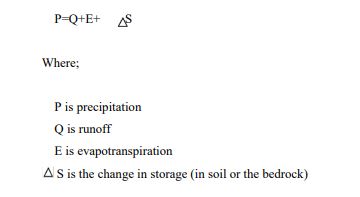The water balance is an accounting of the inputs and outputs of water. The water balance of a place, whether it be an agricultural field, watershed, or continent, can be determined by calculating the input, output, and storage changes of water at the Earth's surface. The major input of water is from precipitation and output is evapotranspiration. The geographer C. W. Thornthwaite (1899-1963) pioneered the water balance approach to water resource analysis. He and his team used the water-balance methodology to assess water needs for irrigation and other water-related issues.
A water balance equation can be used to describe the flow of water in and out of a system. A system can be one of several hydrological domains, such as a column of soil or a drainage basin.
Water balance can also refer to the ways in which an organism maintains water in dry or hot conditions. It is often discussed in reference to plants or arthropods, which have a variety of water retention mechanisms, including a lipid waxy coating that has limited permeability.
A general water balance equation is:

A water balance can be used to help manage water supply and predict where there may be water shortages. It is also used in irrigation, runoff assessment, flood control and pollution control.
Further it is used in the design of subsurface drainage systems which may be horizontal (i.e. using pipes, tile drains or ditches) or vertical (drainage by wells).
To estimate the drainage requirement, the use of a hydrogeological water balance and a groundwater model may be instrumental. The water balance can be illustrated using a water balance graph which plots levels of precipitation and evapotranspiration often on a monthly scale.
francis1897 answered the question on
January 11, 2023 at 08:53